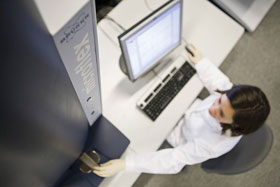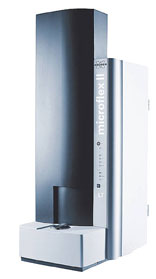Mass spectrometry is not a classic photonic technique. The goal of measuring the mass-to-charge ratio of ions to identify the material from which they originated is mostly electrochemical. Over the years, however, photonic instruments – primarily lasers operating in the UV range – have been used to improve mass spectrometry results. What follows is a brief tour of some of the ways in which laser-based mass spectrometry techniques are expanding biological knowledge.
 Listening to bacterial cells
Listening to bacterial cells
Understanding how cells “talk” to each other ultimately will lead to a greater understanding of human health. With that in mind, Pieter C. Dorrestein of the Skaggs School of Pharmacy and Pharmaceutical Sciences at the University of California, San Diego, in La Jolla, and his colleagues have developed a mass spectrometry technique that allows them to see cell communication as it occurs.
The technique, dubbed natural-product matrix-assisted laser desorption/ionization time-of-flight (Maldi-Tof) imaging mass spectrometry, enables Dorrestein’s team to view simultaneously all of the chemical signals emitted by the cells of their subject, a common bacterium. The group reported its work in the Nov. 8, 2009, issue of Nature Chemical Biology.
Peering at metabolites
Maldi-based mass spectrometry also has proved key to the analysis of cellular metabolites. Hiroyuki Wariishi and his colleagues at Kyushu University in Fukuoka, Japan, brought the technique to bear on high-throughput detection of metabolites of human acute lymphoblastic leukemia Jurkat cells. They placed a limited quantity of the cells into multiwell plates and scanned them. Of the 2500 cell samples, the investigators detected 150 metabolite peaks within 90 s.
 With similar speed, they characterized the effects of several anticancer drug candidates on the metabolite production of the same type of cells. The results have been strong enough to consider Maldi mass spectrometry as a tool for drug screening and validation. Wariishi’s group reported its work in the Jan. 15, 2010, issue of Analytical Chemistry.
With similar speed, they characterized the effects of several anticancer drug candidates on the metabolite production of the same type of cells. The results have been strong enough to consider Maldi mass spectrometry as a tool for drug screening and validation. Wariishi’s group reported its work in the Jan. 15, 2010, issue of Analytical Chemistry.
Working in tandem
One way to anticipate how drugs and other chemical compounds react under varying conditions is to use combinatorial chemistry techniques – rapidly introducing molecules of interest to each other in vast sequences or arrays. One way to do this is to coat beads with one type of molecule – for example, a peptide – and to bring them into contact with a sequence of other compounds.
To improve the sequencing of various peptides on such beads, researchers at the University of Konstanz in Germany used Maldi and Fourier transform ion cyclotron resonance tandem mass spectrometry. They irradiated the sample beads with UV wavelengths from the Maldi laser, which gained them a greater yield of sequence-specific fragment ions. The investigators reported their results in the February 2010 issue of the Journal of the American Society for Mass Spectrometry.
Three times the fun
Maldi is not the only laser-based mass spectrometry technique, nor are drugs and druglike compounds the only subjects worth studying.
 Mass spectrometry also can be used to seek and study minute quantities of many materials. In arenas as different as food safety, biochemical threat assessment and the search for exotic microbial species, work is under way to develop ways to detect smaller and smaller amounts of organic species in sometimes hostile places.
Mass spectrometry also can be used to seek and study minute quantities of many materials. In arenas as different as food safety, biochemical threat assessment and the search for exotic microbial species, work is under way to develop ways to detect smaller and smaller amounts of organic species in sometimes hostile places.
Now, scientists at the University of Tokyo and at Japan’s National Traffic Safety and Environmental Laboratory have developed a novel technique that enables detection of organic molecules in the parts-per-billion range.
The researchers, led by Hiroyuki Yamada, call their device a single-photon ionization time-of-flight mass spectrometer (SPI-Tof-MS). It uses 118-nm pulses generated by frequency tripling of the third harmonic of an Nd:YAG laser to ionize a sample. The investigators report in the Feb. 1, 2010, issue of the International Journal of Mass Spectrometry that they achieved a mass resolution of 800 at about 100 atomic mass units using their device in reflectron Tof-MS mode, and showed how the portable device could be used for online monitoring of diesel engine exhaust.
Mapping the brain
Perhaps most importantly, imaging living tissue using laser-based mass spectrometry techniques is becoming increasingly refined. Case in point, a group led by J. Sabine Becker of Forschungszentrum Jülich in Germany used laser ablation inductively coupled plasma mass spectrometry to determine the distribution of various elements inside brain tissue.
Becker and her colleagues – from Philipps University in Marburg, Germany, and from Zhejiang University in Hangzhou, China, as well as from Jülich – used their imaging technique to map the amounts of iron, copper, zinc and manganese in sections of mouse brains treated to exhibit traits of Parkinson’s disease.
Study of the resulting elemental maps showed patterns of iron and copper distribution that may be ultimately usable as a diagnostic tool but which immediately confirm a role for copper in Parkinson’s disease. Becker’s group reported its work in the January 2010 Journal of the American Society for Mass Spectrometry.